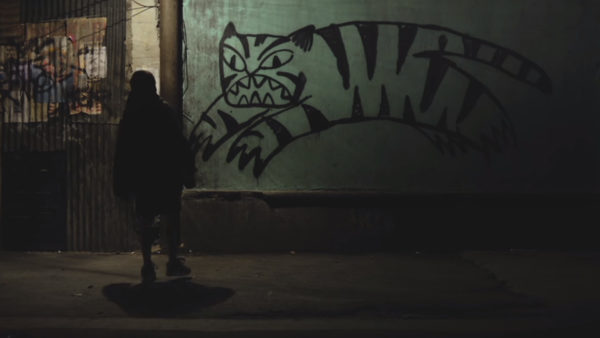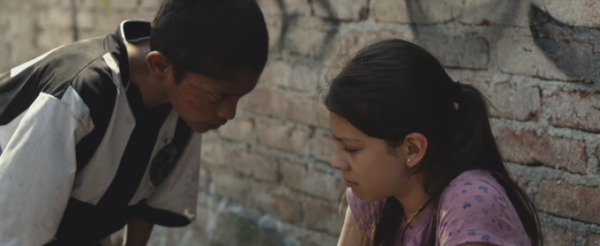
It’s not hard to fathom why Tigers Are Not Afraid has been championed by Guillermo del Toro and Stephen King.
Let’s bitch it out…
There’s an undercurrent of magic and fantasy embedded in Tigers Are Not Afraid that is essential for viewing. There’s such a grim reality in this tale about orphaned, homeless and impoverished Mexican kids evading a dangerous cartel that would be so dark, so pessimistic and so hopeless without the lift that comes from the fairytale and fantasy components.
Thankfully writer/director Issa Lopez knows exactly how to make her story palatable to audiences. Make no mistake, however, this is still a difficult and upsetting film.
Tigers Are Not Afraid wears its thesis on its sleeve from the very first scene. Estrella (Paola Lara) narrates her class assignment, the creation of a fairytale, in voice-over: a prince wishes to be a tiger because the striped animals are not afraid. Alas the prince cannot be a tiger because he has forgotten how to be a prince. It’s a telling metaphor about the film to come, which features children who are thrown into an adult world that strips them of their innocence.
The tranquil, charming glimpse into Estrella’s interior world is interrupted by a school shooting that simultaneously establishes how dangerous the world is and sets the narrative in motion. In the next scene Estrella’s teacher posts a sign confirming that classes are suspended indefinitely and Estrella returns home to discover that her mother has disappeared.
Estrella is the film’s protagonist, but it is her relationship with Shine (Juan Ramón López), the defacto leader of a group of homeless lost boys who scavenge Estrella’s neighbour, that defines the film. After a day and a night without an appearance by her mother, Estrella cautiously ingratiates herself into Shine’s group, which is almost immediately upended by an appearance by the Huasca gang, the film’s villains. The Huascas deal in human trafficking and drugs and they are responsible not only for the abandoned, derelict neighborhood, as well as the abduction and murder of large swaths of people, possibly including Estrella’s mother.

The isolation and lack of supporting characters, especially adults, is one of the most visually distinct aspects of the film. This is an empty world: families are seen moving out, there are constant references to people being abducted and the children at the center of the story are only ever seen fending for themselves. At one point they try to engage the police and the encounter lasts for less than a minute before the officers wave them off and the cruiser drives off.
The messaging is clear: much like a fairytale, no one is coming to save these kids. They must learn how to take care of themselves and solve their own problems.
Unlike an idealistic North American film, the efforts by Estrella, Shine and the others do not always go smoothly and they are not without cost. The children’s decision to go up against members of the Huasca – first by taking credit for a murder that gang leader Chino (Tenoch Huerta) commits, then attempting to outsmart him by using incriminating video footage as leverage – leads to disaster. While the end of the film does ultimately embrace a more optimistic, fairytale outcome, the end of the second act is seriously dark and upsetting.
It is for this reason that Lopez’s use of fantasy visuals becomes so integral. Watching children get shot at, starve, and die is incredibly grim. Estrella’s propensity to hear the voice of her mother and to animate the stuffed tiger of one of the boys provides insight into her coping mechanisms, in addition to reinforcing the child-like perspective through which she experiences the world while simultaneously providing a visual light in the dark for audiences to latch onto.
Intriguingly, just like fairytales, these fantasy elements are not always hopeful and positive. In arguably the most visually spectacular sequence in the film, Estrella is confronted by a spectral horde of the Huasca gang’s victims; their heads and bodies are wrapped in plastic and they’re covered in blood. The victims advance on her like zombies, chasing Estrella into an alley, hands clawing at her from under a sewer grate. This sequence closely adheres to traditional horror movie conventions, and in so doing stands out from both the upbeat fantasy elements and the verisimilitude of the children’s impoverished lifestyle. It’s a terrifying moment in a great film.
The Bottom Line: Tigers Are Not Afraid is a compelling mix of dark fairytale visuals and a grim dissection of poverty and crime in Mexico, all captured through the lens of vulnerable children. The fantastic elements bring levity to the film’s upsetting themes and plot developments, helping writer/director Issa Lopez and her young protagonists soar.